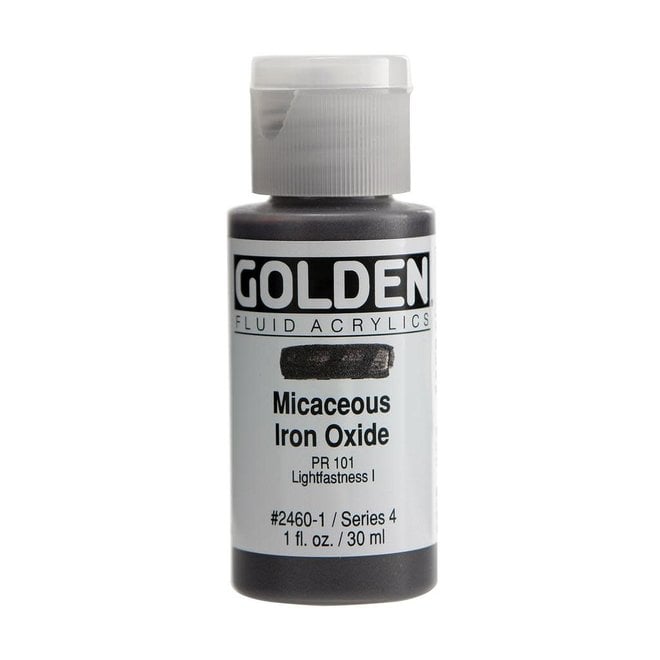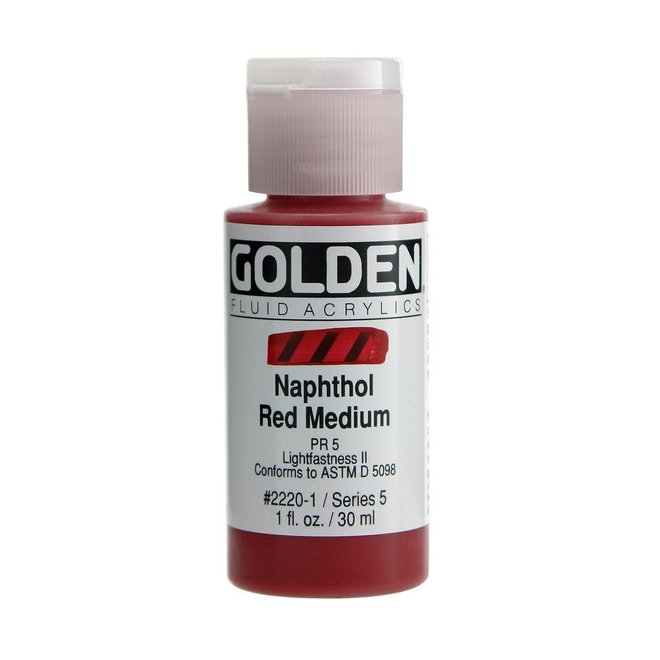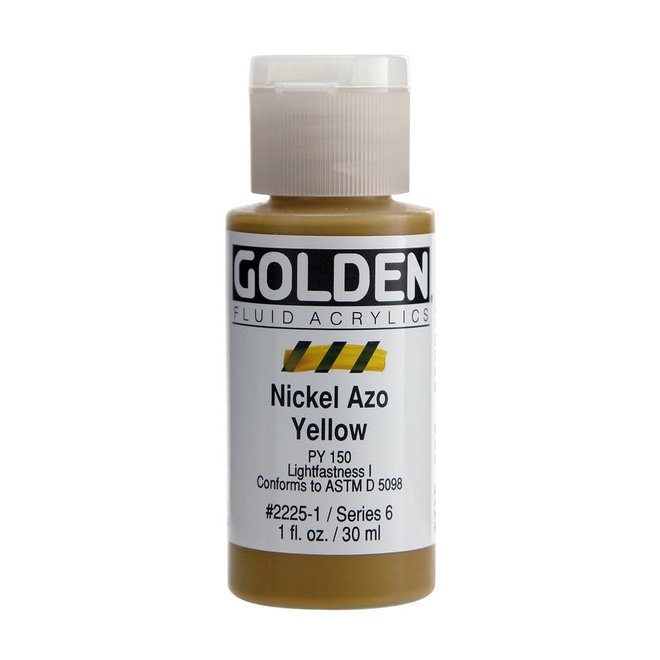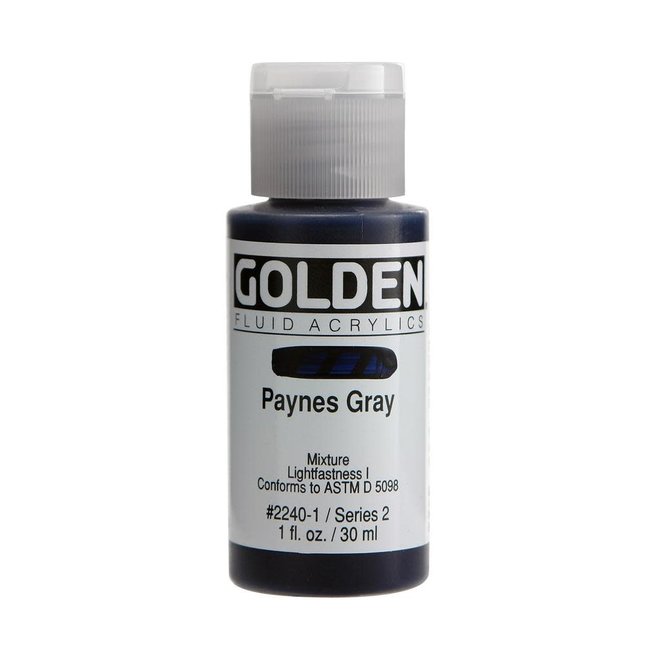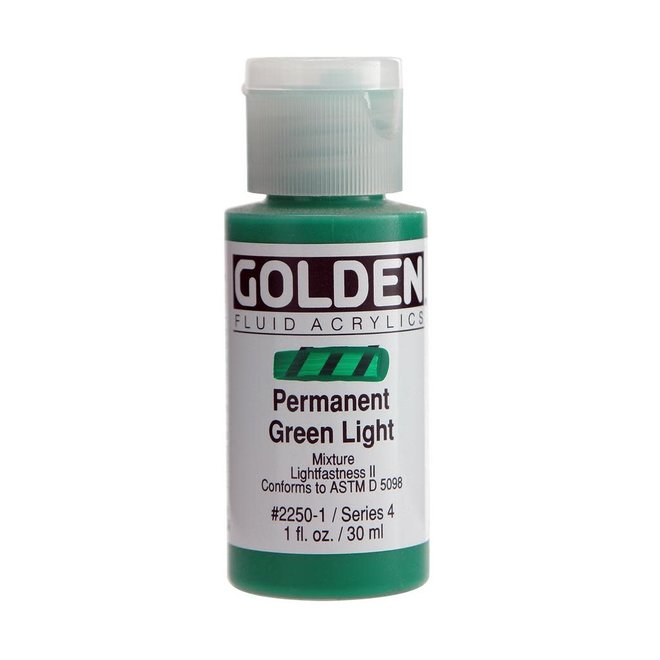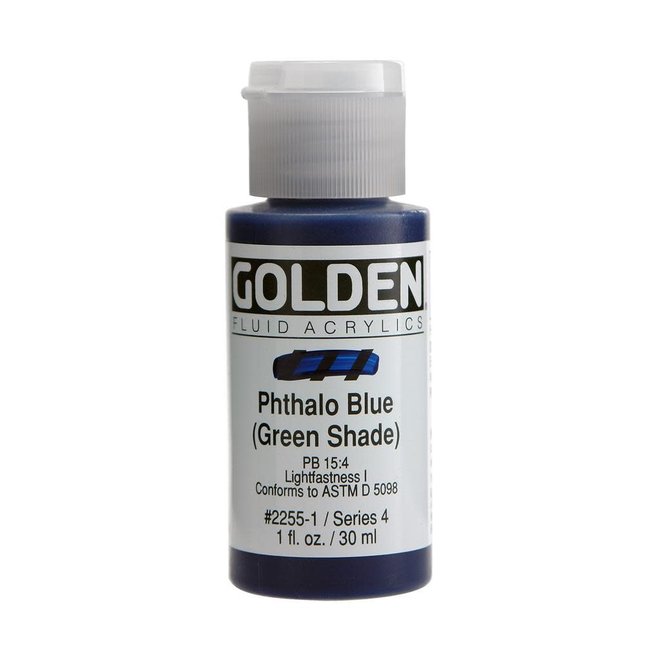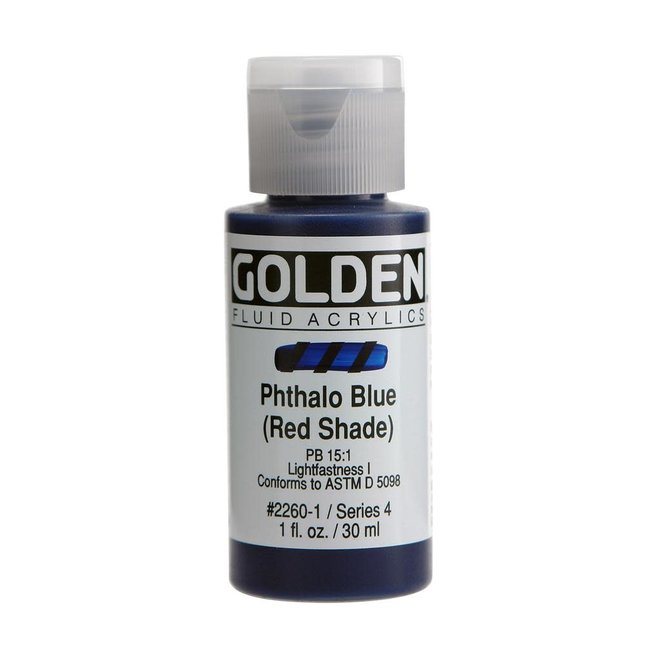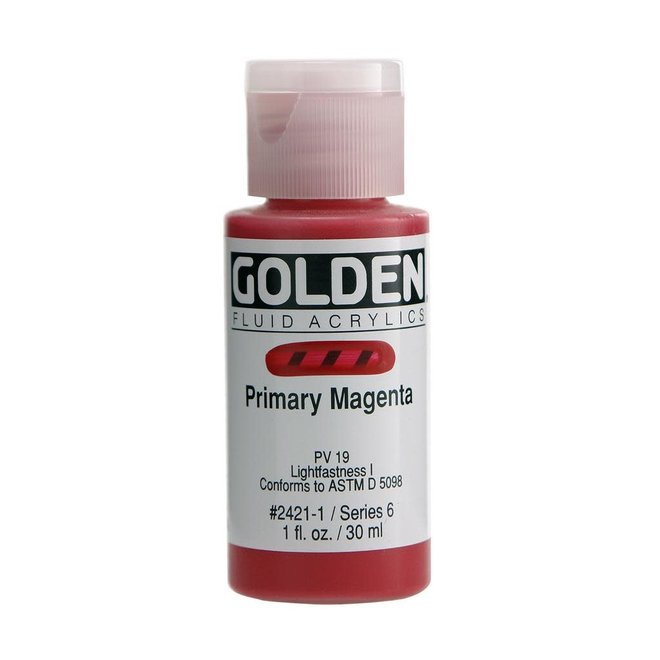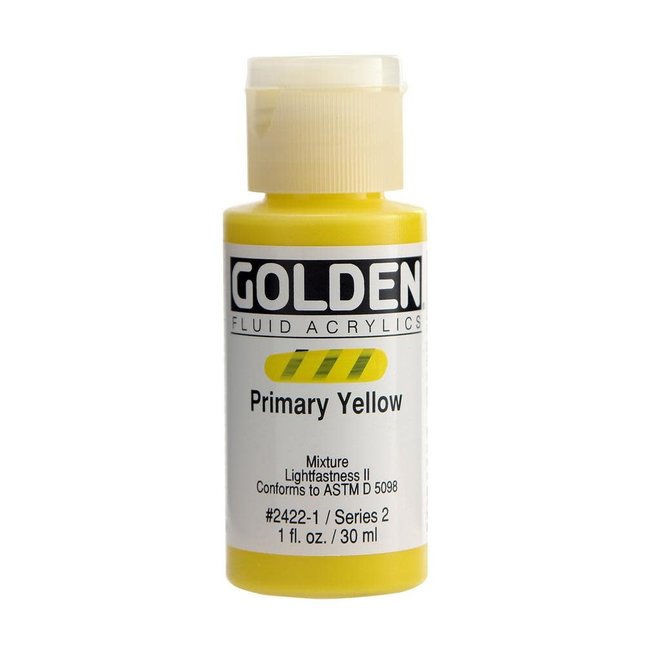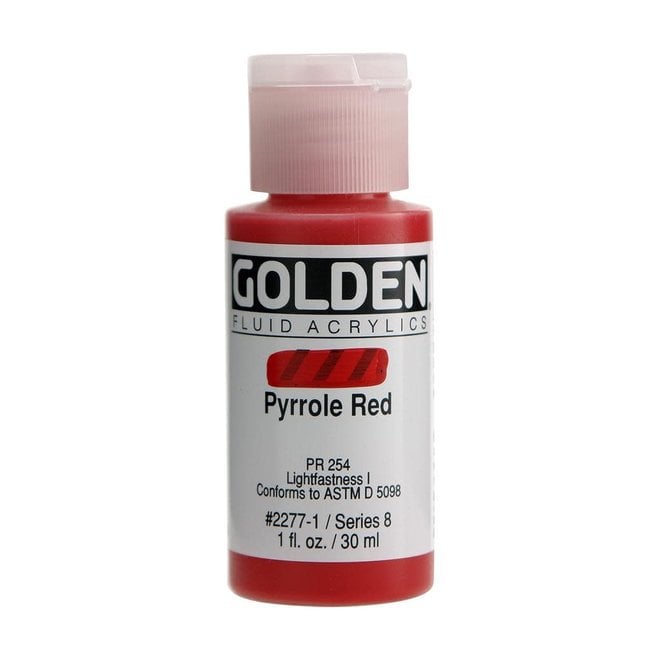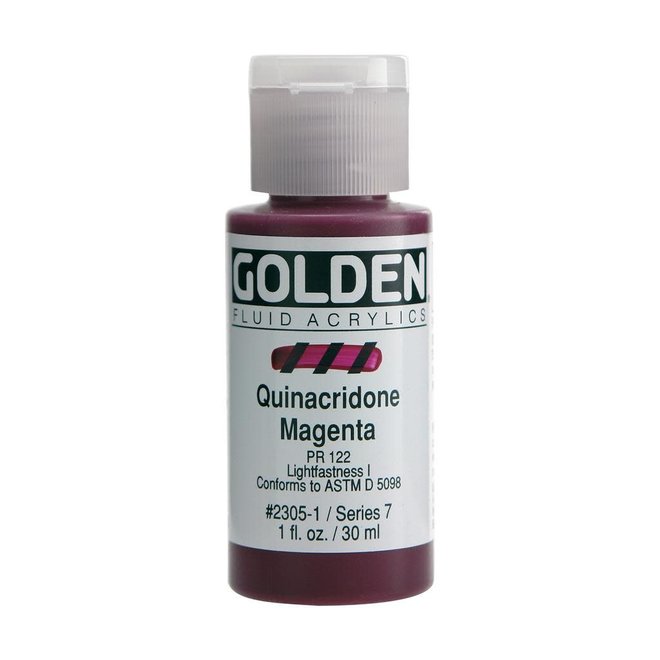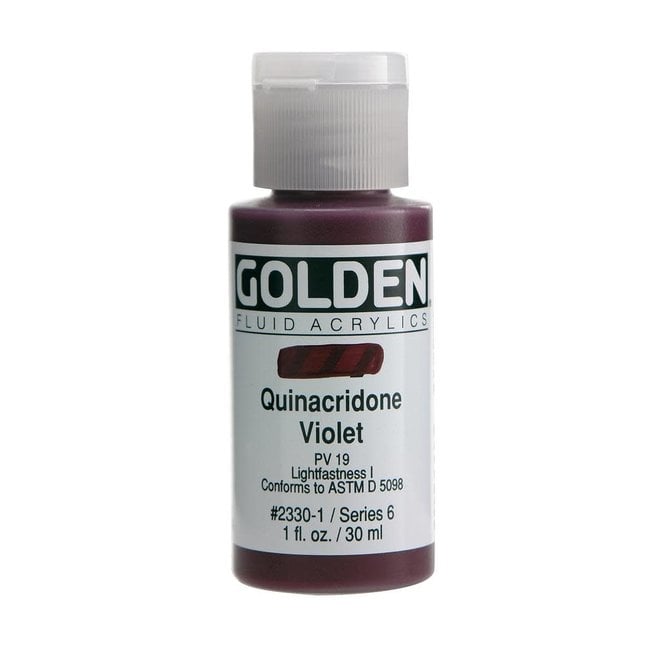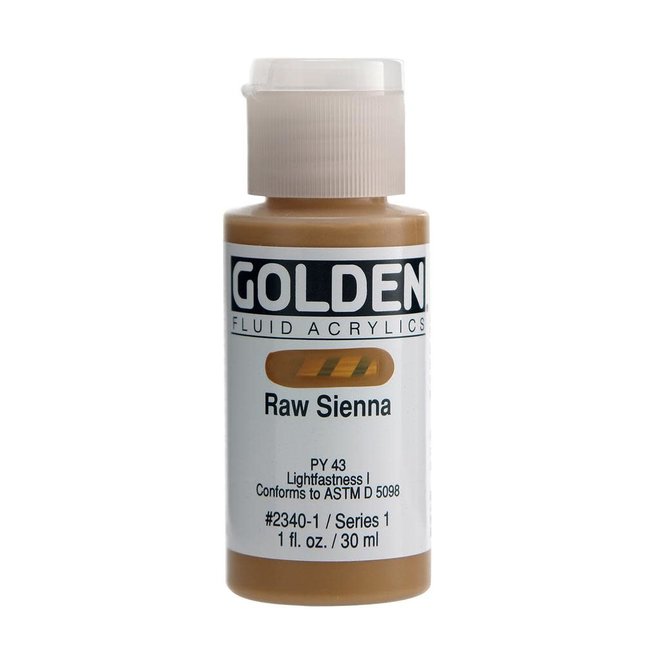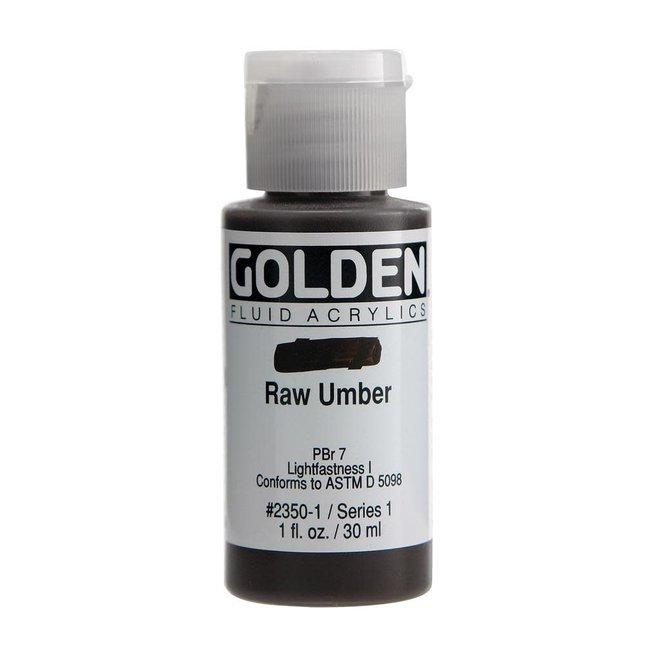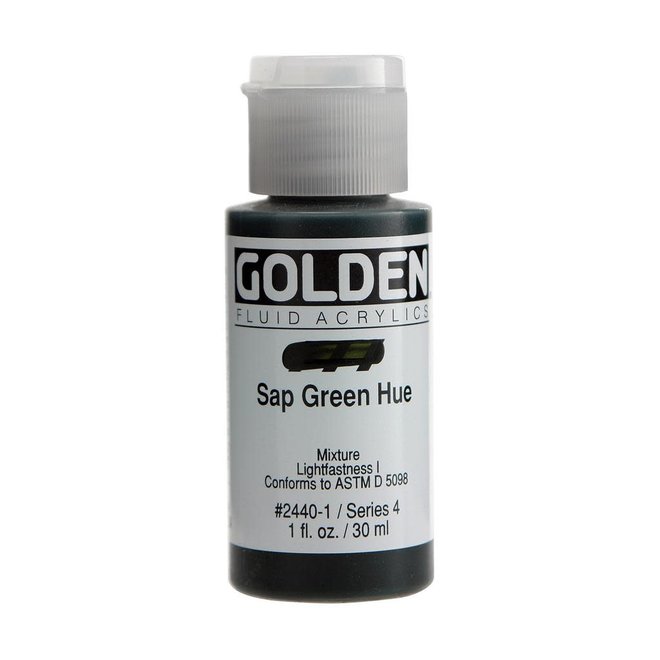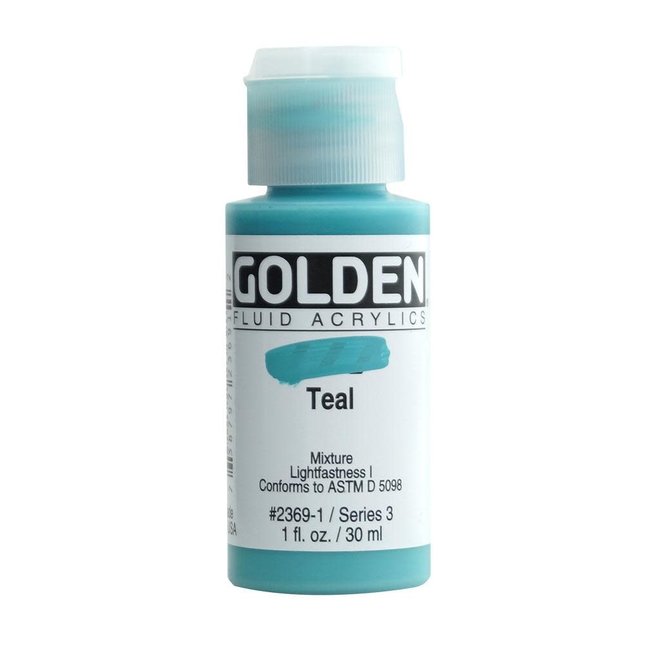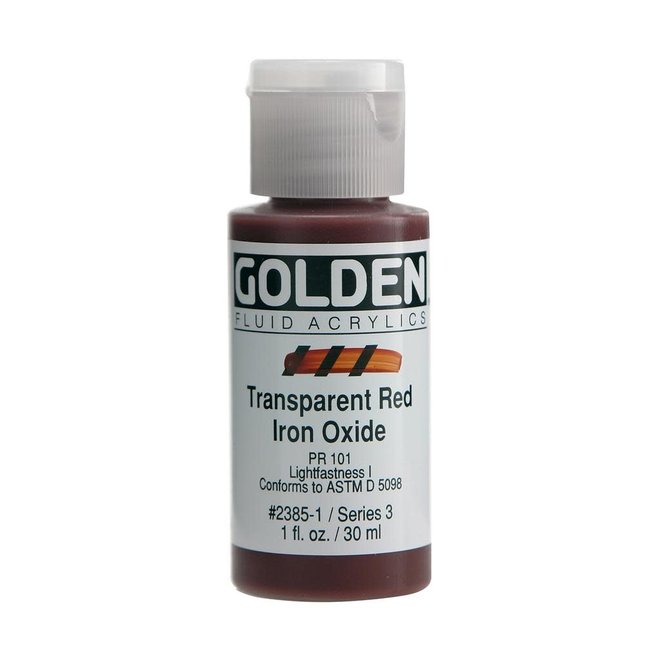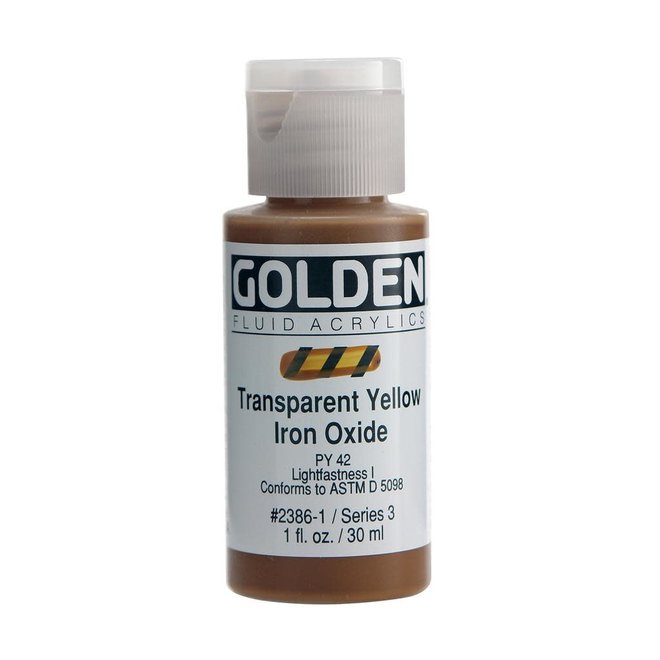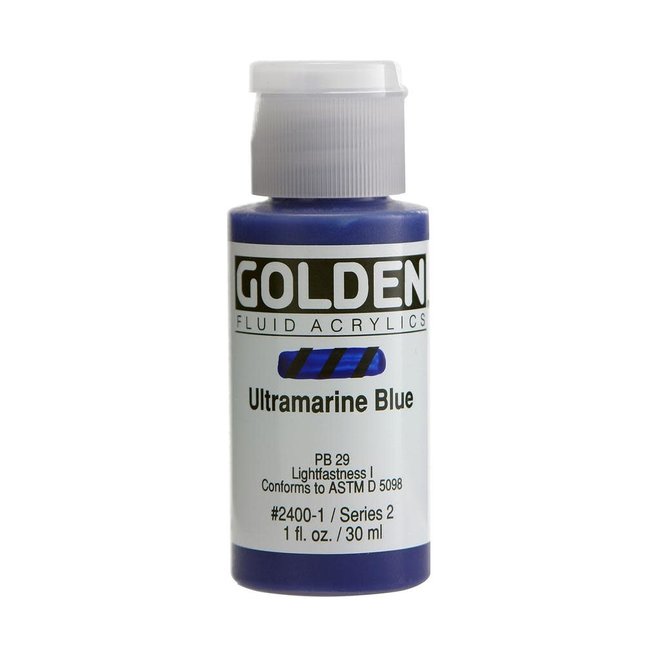FLUID ACRYLICS PRODUCT HISTORY Fluid Acrylics Start as "Custom" Products GOLDEN Artist Colors started creating Fluid Colors on a custom basis for artists requesting a low viscosity, pigment-saturated paint. Some of these artists wanted to pour, puddle and drip their acrylic paints, others wanted to stain with the acrylics using them as alternatives to watercolors, and still others wanted to use the paints for spray application. Many artists were already thinning Heavy Body paints with water to achieve these effects. Although simply adding water or medium to the Heavy Body Acrylics sufficed to meet the needs of most artists, some complained that the resulting paint was not strong enough. These artists desired an undiluted acrylic that would provide optimal tinting strength and coverage.
Eventually, the popularity of the Fluid custom formula reached a point where GOLDEN was able to introduce it as a standard line of product. The Fluid Acrylics are formulated similarly to GOLDEN Heavy Body Acrylics, the main difference being the viscosity or consistency at which the paints are finished. Hence, the pigment load or color strength of the Fluid Acrylics is comparable to the Heavy Body Acrylics. In fact, because of the greater leveling of the Fluid Acrylics, some artists believe the Fluids are actually stronger than the Heavy Body colors.
PRODUCT PROPERTIES Mixing Fluids with other GOLDEN Products The Fluid Colors can be mixed with most of our other GOLDEN Mediums, Grounds, Gessoes, Gels and other paint lines, including our Heavy Body Acrylics, High Flow Acrylics, High Load Colors, Iridescent Colors, Paste Paints and Matte Acrylics. By blending paint lines of different viscosities, artists can create virtually any paint consistency without sacrificing color strength. The Heavy Body Acrylics can be thinned very effectively with water, but since the Fluids start at a lower viscosity, less water is needed. Remember: the more water added to the acrylics, the greater the subsequent shrinking of the paint layer. Too much water will reduce the binding capability of all of the acrylic paints and also tends to flatten out their sheen.
When used for applications other than staining and washes, we recommend diluting the Fluids with no more than a 1:1 ratio of Fluid Acrylic to water. When using the Fluids specifically for staining and washes, there is no limit to how much water can be added. Film integrity will automatically result when the substrate absorbs the paint mixture. Washes can also be sealed with an acrylic medium to increase overall film strength.
Brushing Quality Fluid Acrylics load a brush more evenly than thicker paints, and they also flow consistently off the brush, allowing for longer, more uniform brush strokes. This is one of the key features of the Fluids, resulting from their low viscosity. Artists can lay down thin passages of paint that have high pigment loads; these thin passages would not be possible to achieve by diluting a paint with a higher viscosity.
When a heavier stroke is required, Fluids can be blended with any of the GOLDEN Gels. Soft, Regular, Heavy or Extra-Heavy Gels will all thicken the paint to various extents. Because of the thin consistency and potency of the Fluids, they are the easiest of all the paint systems to incorporate into powerful gel mixtures.
Pours & Puddles The Fluids can be poured and puddled, dripped and dragged onto the canvas to achieve some unique effects. By altering the speed, the distance from the substrate and nozzle size or shape while pouring, one can control the size and shape of the resulting pour or drip. Working with different Fluid colors together, either simultaneously or at different times, can be an interesting technique.
There are a few GOLDEN mediums that work especially well with the Fluids for various pour/drip/puddle effects. Adding small amounts of GAC-800 to the Fluids can reduce the crazing that occurs. Clear Tar Gel mixes with the Fluids for dripping purposes, and can yield lines that range from spider-web fine to brushstroke thick.
Thick Film Drying Considerations When paint is being applied in relatively thick films, one must remember that all acrylic paints shrink considerably (approximately 25-40%) upon drying. This tendency, coupled with the thin consistency of the Fluids, will yield surface defects called crazes. Crazing is the result of the tremendous force exerted on the surface of the paint film as the film dries and shrinks. It can appear as rips, tears or valleys that run through the surface of the poured paint. Blending Fluids with GOLDEN Soft, Medium, Heavy or Extra Heavy Gels will significantly help to prevent crazing.
Product Gloss Variance In keeping with the standards created by our Heavy Body Acrylics, when formulating the Fluid line we consciously decided not to add the flattening agents or opacifiers typically added to other acrylic paints. Such fillers are frequently added to unify the sheen of a line of paints and to make all colors uniformly opaque. We decided that each pigment would be made to its own level of matte or gloss and its own unique degree of opacity or transparency, depending upon its own intrinsic nature. These decisions have allowed our colors to retain their clearest and cleanest quality, especially when used in washes or glazes where their brilliance is displayed. It is always possible to add matting agents and other whitening materials to the product, but once added, it is impossible to take them away.
Because the Fluid Acrylics contain no flattening agents or opacifiers, it is quite evident when looking at our color chart that our colors do vary in gloss. For example, our Ultramarine Blue or Raw Umber appear quite matte, while the Dioxazine Purple and Vat Orange are extremely glossy. Although some artists find this variation problematic, many artists appreciate the nuances of color, sheen, and transparency or opacity that exist within our Fluid line. (For artists desiring a consistent sheen and opacity in a fluid paint line, our Matte Fluids provide this option. See below for more information.)
Film Flexibility The Fluid colors retain excellent flexibility when dry, greatly diminishing the likelihood of the cracking that occurs in other natural and synthetic polymer systems. The acrylics can absorb the constant stress and strain placed on canvas when shipped or as it expands and contracts with changes in temperature and humidity. Please note: acrylics begin to harden at 15 degrees Centigrade or 59 degrees Fahrenheit, and become quite hard at temperatures below freezing. This is especially important to remember when shipping a painting in freezing conditions or when unrolling a painting that has been kept in cold storage. The paint will not spontaneously crack when frozen, but because it will be very brittle, care should be exercised in handling. When a painting has been exposed to such cold conditions, it is important to allow it to warm sufficiently before rolling, unrolling or any other handling occurs.
COLOR RANGE The Main Set of Colors The Fluid Acrylic line, although smaller in color range than the Heavy Body line, contains a wide variety of pigment options. Many artists have wondered why we do not include all the Heavy Body colors in the Fluid line. There are many reasons preventing us from doing so. Because of the consistency of the Fluids, some of the heavier metal pigments do not remain stable in the thinner consistency. The heavier pigments may tend to settle out, densely packing on the bottom of the container where they cannot be restirred very easily. Viscosity stability is a common problem, as it is often difficult to maintain such a low viscosity (thin paint) with such a high pigment load over the course of time.
The Fluid Iridescent Colors The Fluid Iridescent Colors are one of the most unique products available to artists today. They are well-known for their luster quality and offer highly reflective metallic variations. They can be used alone or mixed with other GOLDEN colors. Adding glossy gels or mediums to Iridescent colors will also increase their luster quality.
Most of the Iridescent Acrylics are made from mica particles coated with Titanium Dioxide and are very resistant to fading. Some are made from metal and metal oxides, such as Iridescent Stainless Steel and Micaceous Iron Oxide. The Iridescent acrylics will not oxidize or tarnish since they are made from stainless steel, naturally occurring minerals such as mica, or fully oxidized materials (Refer to Interference & Iridescent Acrylics Product Information Sheet for more information).
The Fluid Interference Colors The GOLDEN Interference Colors achieve their reflective properties by synthetically reproducing a natural phenomenon-the nacreous, or pearlescent, quality found in fish scales, peacock feathers or the dust of a butterfly's wing. Golden produces 6 Fluid Interference Colors and four Interference Oxide Colors in Fine consistency only. All of GOLDEN"s Interference Colors produce a luster quality by themselves, or when mixed with other colors and mediums. (Refer to Interference & Iridescent Acrylics Product Information Sheet for more information).
Fluid Matte Acrylic Line The sheen of the Fluid acrylics can be altered with gels, mediums or varnishes. However, for those artists looking for a paint line with uniform matte finish, GOLDEN offers the Matte Acrylics. The Matte Fluid Acrylics are essentially the same as the regular Fluids, except matting agents are added to glossier colors.
PIGMENT SELECTION The Fluid line is divided among inorganic and organic pigments. Inorganic Pigments Some inorganic pigments have been around for centuries and some for millennia. They are produced either with naturally mined pigments (sienna, umber, ochre) or with synthetically manufactured pigments, (iron oxide, carbon black, etc). Inorganic pigments may also be produced using a combination of these two processes. Pigments that are both mined and manufactured include the Cadmiums, Cobalts, and Titaniums.
Organic Pigments The organic pigments are a group of colors that are synthetically produced through complex carbon-containing chemistry involving various materials including petroleum, coal tar and natural gas. Many of these pigments have their roots in the chemistry of the 1800's, although widespread production didn"t really begin until the 1930's. Even though they have only been available for several decades, organic pigments have demonstrated remarkable abilities to withstand the impact of light and weather.
Pigment Selection & ASTM Standards Every color within the Fluid Line is approved for professional artist use according to ASTM Standards for Artist Materials. These standards regulate paint consistency and demand fineness and lightfastness of chosen pigments, use of 100% acrylic binder, freeze-thaw stability, and accuracy of labeling for pigments used. Evaluation by an approved toxicologist is required.
Of the 51 colors currently in the Fluid line, 45 are considered excellent in lightfastness (the ability to withstand color change due to exposure to light). The remaining 6 are rated very good for lightfastness. GOLDEN does not use any colors within the Fluid line rated less than very good. Those colors rated as very good include Green Gold, Naphthol Red Light, Naphthol Red Medium, Hansa Yellow Light, Permanent Green Light, and Dioxazine Purple.
PIGMENT FAMILIES The Quinacridone Family: The GOLDEN Acrylic lines contain more Quinacridones than any other acrylic line of paint. Quinacridone pigments produce seven intense colors ranging from deep yellow to vibrant violet. All of the Quinacridones, because of their vibrant undertones and high transparencies, tend to be excellent mixing colors. They tend not to muddy or gray, retaining their brightness.
Perhaps the most important GOLDEN Quinacridone color is Quinacridone Crimson, a color with excellent lightfastness and similar working qualities to the more fugitive Alizarin Crimson. GOLDEN Quinacridone Crimson possesses the deep burgundy mass tone as well as the bright, rosy undertone of traditional Alizarin. GOLDEN's Quinacridone Crimson has been used by conservation professionals to replace the fugitive Alizarin when restoring paintings. Like all of GOLDEN's Quinacridones, Quinacridone Crimson is exceptionally transparent and works particularly well as a mixing color. Mixing Quinacridone Crimson with Phthalo Green B/S will almost magically produce one of the deepest blacks imaginable.Quinacridone/Nickel Azo Gold and Quinacridone Burnt Orange. These Quinacridones have a luminosity that rivals the richest oil colors. Their mass tones tend to be quite dark, yet their undertones are incredibly vibrant. Quinacridone/Nickel Azo Gold looks very close to a Burnt Sienna in its mass tone, yet its undertone has a yellow fire not found in any Sienna. Similarly, Quinacridone Burnt Orange has a brown-red mass tone that reveals a brilliant red orange underneath.
Quinacridone Red is GOLDEN's recommendation when a very intense mixing magenta primary is requested. It is very close in hue to the color gels produced by Kodak for primary magenta at 5500 Kelvin. Quinacridone Magenta and Violet tend to be excellent choices for mixing colors in the lavender through purple range, with the addition of various transparent blues. Quinacridone Red, Red Lt., Magenta and Violet produce high intensity pinks through lavenders when mixed with white. GOLDEN recommends using these colors when a punch of a fuchsia or fluorescent color is needed, yet permanency is also required, for a particular work of art.
The Phthalocyanine Family: The Phthalocyanines are known as the oldest organic pigments. The GOLDEN Fluid line contains 5 Phthalocyanine colors, including Phthalo Green (Yellow Shade) and Phthalo Green (Blue Shade), Turquois (Phthalo), and two Phthalo Blues, (Green Shade) and (Red Shade). These different Phthalocyanine colors actually contain the various pigment forms of the Phthalocyanine group.
The Cobalt Family: The Cobalt Fluid colors include Cerulean Blue and Blue Deep (these contain both Cobalt and Chromium), and Cobalt Blue.
The Pyrrole Family: The Pyrrole family is one of the newer pigment families to be developed. The Pyrroles are almost as opaque and, in fact, brighter than our Cadmium colors. Pyrrole Orange, Pyrrole Red Light, and Pyrrole Red exhibit excellent opacity and lightfastness. They also offer clean mixing with other organics, unlike their Cadmium counterparts, which produce muddier blends.
Disclaimer The above information is based on research and testing done by Golden Artist Colors, Inc., and is provided as a basis for understanding the potential uses of the products mentioned. Due to the numerous variables in methods, materials and conditions of producing art, Golden Artist Colors, Inc. cannot be sure the product will be right for you. Therefore, we urge product users to test each application to ensure all individual project requirements are met. While we believe the above information is accurate, WE MAKE NO EXPRESS OR IMPLIED WARRANTIES OF MERCHANTABILITY OR FITNESS FOR A PARTICULAR PURPOSE, and we shall in no event be liable for any damages (indirect, consequential, or otherwise) that may occur as a result of a product application.

